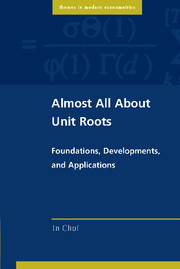Book contents
- Frontmatter
- Dedication
- Contents
- Foreword
- Preface
- Abbreviations and Notation
- 1 Introduction
- 2 Inference on Unit Roots: Basic Methods
- 3 Unit Root Tests under Various Model Specifications
- 4 Alternative Approaches to Inference on Unit Roots
- 5 Other Issues Related to Unit Roots
- 6 Seasonal Unit Roots
- 7 Panel Unit Roots
- Epilogue
- References
- Index
3 - Unit Root Tests under Various Model Specifications
Published online by Cambridge University Press: 05 May 2015
- Frontmatter
- Dedication
- Contents
- Foreword
- Preface
- Abbreviations and Notation
- 1 Introduction
- 2 Inference on Unit Roots: Basic Methods
- 3 Unit Root Tests under Various Model Specifications
- 4 Alternative Approaches to Inference on Unit Roots
- 5 Other Issues Related to Unit Roots
- 6 Seasonal Unit Roots
- 7 Panel Unit Roots
- Epilogue
- References
- Index
Summary
Introduction
Chapter 2 used the standard AR model for the inference on unit roots. However, one may contemplate testing for a unit root using different model specifications, and doing so might result in different inferential results. This chapter introduces inferential procedures for a unit root that use model specifications that depart from the standard AR model.
The first section of this chapter addresses unit root tests under structural changes in the non stochastic regressors added to the AR model. This research area, initiated by Perron (1989), received much attention because the presence of structural changes in the parameters of non stochastic regressors sometimes yields different inferential results. It also provided further challenges for econometric theorists and resulted in various new inferential procedures. The second section examines unit root tests with conditional heteroskedasticity. Because conditional heteroskedasticity is known to be prevalent in high-frequency financial time series, it is natural to consider unit root testing in its presence. As is discussed, the presence of conditional heteroskedasticity brings some complications in devising unit root tests. This chapter then addresses unit root tests in the presence of additive and innovational outliers. It is well-known that outliers can affect inferential results in a significant manner. This section discusses the effects of outliers on unit root testing and the methods of unit root testing in the presence of outliers. The fourth topic of this chapter encompasses unit root distributions and tests under fat-tailed distributions. This discussion show that fat-tailed distributions introduce nuisance parameters in the limiting distributions of Dickey and Fuller's (1979) and Phillips and Perron's (1988) test statistics. The last topic of this chapter is unit root tests against nonlinear alternatives. This discussion considers threshold AR and smooth-transition AR models, which are representative nonlinear models in time series analysis. In addition, it introduces inference methods using random-coefficient AR models. A summary and further remarks conclude the chapter.
- Type
- Chapter
- Information
- Almost All about Unit RootsFoundations, Developments, and Applications, pp. 58 - 87Publisher: Cambridge University PressPrint publication year: 2015



